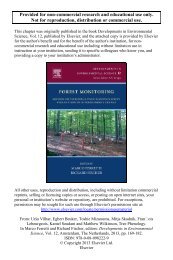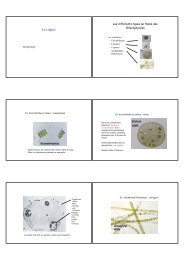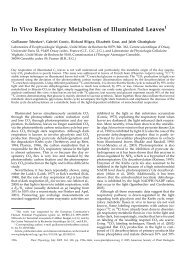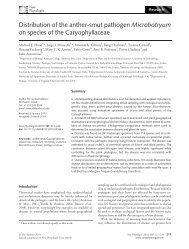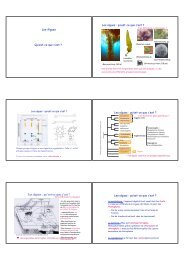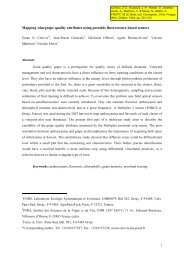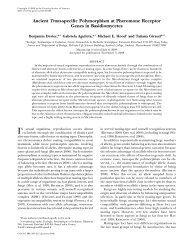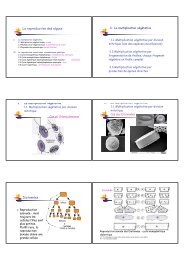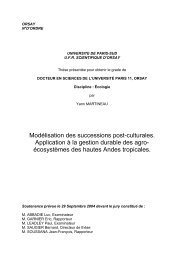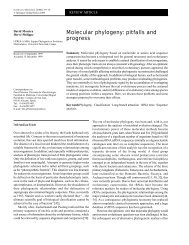Inverse density dependence and the Allee effect - Personal Web ...
Inverse density dependence and the Allee effect - Personal Web ...
Inverse density dependence and the Allee effect - Personal Web ...
Create successful ePaper yourself
Turn your PDF publications into a flip-book with our unique Google optimized e-Paper software.
PERSPECTIVESPer capitagrowth rate(dN/Ndt)Density<strong>dependence</strong><strong>Inverse</strong> <strong>density</strong><strong>dependence</strong> (<strong>Allee</strong> <strong>effect</strong>)Box 1. The floury little worldof <strong>the</strong> TriboliumOne of <strong>the</strong> earliest illustrations of <strong>Allee</strong>’s ideasof <strong>the</strong> existence of an optimal population sizeconcerns his analysis of <strong>the</strong> laboratory work ofthree different researchers on <strong>the</strong> flour beetle,Tribolium confusum 35 . This species showed <strong>the</strong>‘most rapid population growth at an intermediatepopulation size ra<strong>the</strong>r than with too few ortoo many present’, as shown in his figure,reproduced below.K —(unstable)Fig. 1. Illustration of <strong>the</strong> <strong>Allee</strong> <strong>effect</strong>, from a very simple ma<strong>the</strong>matical model of population dynamics:dNdtThe per capita growth rate (dN/dt) is negative above <strong>the</strong> carrying capacity (K) <strong>and</strong> positive below. However,in <strong>the</strong> presence of an <strong>Allee</strong> <strong>effect</strong>, it also decreases below a given population size, <strong>and</strong> can even becomenegative below a critical population threshold (K ). When a population displaying this type of populationdynamics is driven below <strong>the</strong> critical threshold, <strong>the</strong> low, sometimes negative, per capita growth rate maylead it to extinction.æ N öæN ö= rNç1-÷ -è K øç 1è K÷ø-K(stable)Populationsize (N )fertile), distributed across four isl<strong>and</strong>s 7 .A recent breeding program has resultedin <strong>the</strong> birth of nine chicks, but only two of<strong>the</strong>se are female (R. Dennett, pers. commun.).The third category concerns <strong>the</strong>reduction in cooperative interactionswhen <strong>the</strong>re are fewer individuals.This last mechanism has attractedmost research effort, probably partlybecause <strong>Allee</strong> himself proposed it, referringto it as ‘proto-cooperation’ or ‘facilitation’1 . Given that cooperation usuallyimplies active participation, we prefer touse <strong>the</strong> more generalist term of facilitation,except for particular cases. Shortage ofreceptive mate encounters during <strong>the</strong> matingperiod when <strong>density</strong> is too low 8 is <strong>the</strong>most cited factor, although it representsonly a small subset of social causes ofinverse <strong>density</strong> <strong>dependence</strong>. Species inwhich fitness is enhanced by any type ofconspecific facilitation might suffer fromreduced <strong>density</strong> when intraspecific competitiveprocesses are of secondary importance(Box 2). In this context, facilitation istaken in <strong>the</strong> broadest sense <strong>and</strong> sometimesincludes sexual reproduction (where twoorganisms can be seen as ‘cooperating’ topass on <strong>the</strong>ir genes to <strong>the</strong> next generation).For example, decreased sexual reproductionowing to a lower probability offinding a mate at very low densities mightgenerate a lower rate of recruitment,which in turn lowers <strong>the</strong> probability offinding mates in <strong>the</strong> next generation,<strong>the</strong>reby creating an extinction vortex,<strong>and</strong> ultimately <strong>the</strong> collapse of <strong>the</strong> population.Additionally, in cooperative animals,reduced recruitment may also becaused by higher juvenile mortality,owing to <strong>the</strong> cost of feeding or babysittingin small groups 9 as in suricates,Suricata suricatta.The <strong>Allee</strong> <strong>effect</strong> might also be generatedby lower survival, such as whenantipredator strategies become inefficientin small groups of prey. Examplesof this include <strong>the</strong> passive protection ofTrends in Ecology & EvolutionReproduction rate(per female per day)87654311 days2125 days00 2 4 8 16 32 64Initial <strong>density</strong>(in 32 mg of flour)Trends in Ecology & Evolution(Online: Fig. I)The higher growth rate at an intermediatepopulation size was interpreted as <strong>the</strong> resultof <strong>the</strong> interaction between two opposingprocesses. On one h<strong>and</strong>, ‘adult beetles roamat r<strong>and</strong>om through <strong>the</strong>ir floury universe. Theyeat <strong>the</strong> flour, but <strong>the</strong>y also eat <strong>the</strong>ir own eggsas <strong>the</strong>y encounter <strong>the</strong>se on <strong>the</strong>ir travels’ 35 .Because of this, eggs are less likely to escapeoophagy at high densities. However, femaleslay more eggs, <strong>and</strong> eggs with a higher percentageof fertility, when <strong>the</strong>y have been stimulatedby successive copulation, which is morelikely to occur at high densities. As a result,<strong>the</strong>re is an intermediate optimal population<strong>density</strong>, above <strong>the</strong> possible minimum one, inwhich <strong>the</strong> growth rate is higher than at lower orhigher population densities. Later, <strong>Allee</strong> <strong>and</strong>collaborators 35 showed that fish are betterable to survive water poisoning if o<strong>the</strong>r fishhad previously lived in it, because <strong>the</strong>ir secretionshad conditioned <strong>the</strong> environment. Thisrelationship between fitness <strong>and</strong> <strong>density</strong> was,however, positive only until competitionbecame <strong>the</strong> principal factor influencing populationdynamics. Such an interaction betweentwo processes with an opposing relationshipto <strong>density</strong> is a reasonably general feature of<strong>the</strong> <strong>Allee</strong> <strong>effect</strong>.sea urchin larvae sheltered by adultspine canopies 10 , <strong>the</strong> early warning orconfusion <strong>effect</strong>s in fish schools <strong>and</strong>ungulate herds 11 , or more active sentinelsystems or defence strategies, as in suricates12 . However, because <strong>the</strong> extent offacilitation <strong>and</strong>/or cooperation mightdetermine <strong>the</strong> strength of <strong>the</strong> <strong>Allee</strong><strong>effect</strong>, many of <strong>the</strong>se processes could bera<strong>the</strong>r weak unless <strong>the</strong> populations areat very low <strong>density</strong>. In contrast, obligatecooperatively breeding species mightexperience a strong inverse <strong>density</strong><strong>dependence</strong>, even when close to <strong>the</strong> carryingcapacity, <strong>and</strong> may suffer from an<strong>Allee</strong> <strong>effect</strong> for most of <strong>the</strong>ir normal <strong>density</strong>range 12,13 .406 TREE vol. 14, no. 10 October 1999
PERSPECTIVESFig. 2. Examples of <strong>the</strong> <strong>Allee</strong> <strong>effect</strong> in different taxa. (a) Because of a shortage of fertilization or of mating encounters, <strong>Allee</strong> <strong>effect</strong>s can cause species extinctionwhen <strong>density</strong> is too low. This is illustrated by pollination in fig trees (Ficus sp.), where small dispersed patches attract fewer pollinators or dispersers (photo reproduced,with permission, from Corbis/C. Mattison). (b) The <strong>Allee</strong> <strong>effect</strong> is important in group living animals, such as schooling fishes (here bluefin tunas Thunnus thynnusin fishing nets). It may also cause a population to collapse if harvesting pressure is too strong, as has happened for fisheries (photo reproduced, with permission,from Corbis/J.L. Rotman). (c) Because fruit flies attack more than 400 crops worldwide, <strong>the</strong>y are considered to be one of <strong>the</strong> worst insect pests of agriculture. Oneof <strong>the</strong> techniques used to control <strong>the</strong>m is <strong>the</strong> release of sterile males to create an <strong>Allee</strong> <strong>effect</strong>, as for <strong>the</strong>se fruit flies, Anastrepha ludens (photo reproduced, withpermission, from J. Dykinga, Agricultural Research Service, USDA). Ano<strong>the</strong>r technique is to release natural enemies, in numbers large enough to ensure <strong>the</strong> <strong>Allee</strong><strong>effect</strong> is avoided. (d) At very small population sizes, some endangered species, such as <strong>the</strong> Kakapo (Strigops habroptilus), have a low probability of finding receptivemates, <strong>and</strong>/or have a biased sex-ratio because of demographic stochasticity. There are only 54 individuals surviving of this giant parrot (photo reproduced, withpermission, from D. Merton). (e) Obligate cooperative breeders, such as African wild dogs (Lycaon pictus), may have a critical group size below which <strong>the</strong> groupwould be very likely to go extinct (photo reproduced, with permission, from J. Ginsberg).Implications for populationdynamicsFor all <strong>the</strong>se phenomena, <strong>and</strong> o<strong>the</strong>rs,<strong>the</strong> major consequence of <strong>the</strong> <strong>Allee</strong> <strong>effect</strong>is <strong>the</strong> existence of a critical <strong>density</strong> belowwhich <strong>the</strong> aggregation unit considered(e.g. population, colony or social group)is likely to go extinct. This has beenshown <strong>the</strong>oretically both with deterministic<strong>and</strong> stochastic ma<strong>the</strong>matical models4,13,14 , <strong>and</strong> although still scarce, empiricalevidence exists from very diverseecological systems (Box 2). Because <strong>the</strong>mechanism is quite straightforward, verybasic population dynamic models (comparablein simplicity to <strong>the</strong> classicalVerlhust logistic equation) can be usedto mimic <strong>the</strong> <strong>Allee</strong> <strong>effect</strong> (Fig. 1).TREE vol. 14, no. 10 October 1999 407
PERSPECTIVESBox 2. <strong>Allee</strong> <strong>effect</strong>s, facilitation <strong>and</strong> cooperationThe <strong>Allee</strong> <strong>effect</strong> can be generated by a shortage of interactions among conspecifics at low <strong>density</strong>. Theseinteractions range from strict cooperation to unconscious facilitation. At one extreme, strong cooperation,are taxa that form colonies (with different degrees of coloniality). For example, because offspringsurvival to maturity increases with colony size, <strong>the</strong> lifetime reproductive success of female social spiders,Anelosimus eximius, decreases in small colonies 36 . Smaller colonies of reef-building coral populationsare less likely to survive attacks by mucilage coverage 37 or catastrophic climatic events 33 . InDamaral<strong>and</strong> mole-rats, Cryptomys damarensis, small colonies are more likely to fail because <strong>the</strong> colonywork force is of insufficient size to locate food 38 . In plants, lower survival can be caused by a lack of conditioning<strong>effect</strong>s at low densities 39 , <strong>and</strong> some colonial seabirds need a critical <strong>density</strong> to establish <strong>and</strong>reproduce 1,40 .At <strong>the</strong> o<strong>the</strong>r extreme of sociality are individuals of species whose only form of contact with conspecificsis for sexual reproduction (which can in this context be considered as proto-cooperation). They can alsobe subject to <strong>Allee</strong> <strong>effect</strong>s. For example, pollination of many species of plants (especially by animalvectors), is less efficient when inter-individual distances become too large or patches too small 39,41,42 .Fertilization in benthic invertebrates with free-spawn gametes, or with planktonic larvae, has also beenshown to be insufficient at low population densities 33 . A shortage of encounters with receptive matesduring <strong>the</strong> mating period 8 can increase <strong>the</strong> threat to small populations, such as those of <strong>the</strong> Glanvillefritillary butterfly, Melitaea cinxia 18 , <strong>and</strong> <strong>the</strong> nor<strong>the</strong>rn spotted owl, Strix occidentalis 43 . An <strong>Allee</strong> <strong>effect</strong> mayalso delay <strong>the</strong> beginning of an invasion 32 , or even prevent its success, as seen in <strong>the</strong> House Finch,Carpodacus mexicanus, in North America. The same is true for species introductions (for <strong>the</strong>ir conservationor for biological control of ano<strong>the</strong>r species), which generally require repeated releases of large numbersof individuals before successful establishment 44,45 .Between <strong>the</strong>se two extremes, <strong>the</strong> atypical social system of obligate cooperative breeders can generatean <strong>Allee</strong> <strong>effect</strong>, potentially responsible for <strong>the</strong>ir high rates of group extinction 13 (Box 3).The implications of <strong>the</strong> <strong>Allee</strong> <strong>effect</strong> arepotentially very important in most areasof ecology 15 <strong>and</strong> evolution 14 , but we willfocus here on population dynamics only.As we will see below, <strong>the</strong> practical managementof population numbers, whe<strong>the</strong>raiming to increase or reduce <strong>the</strong>m, isstrongly affected by this <strong>effect</strong>. The consequencesof <strong>Allee</strong> <strong>effect</strong>s are also likely tobe significant for <strong>the</strong> <strong>the</strong>ory of populationdynamics, because most classic modelsimply a linear decrease of growth with<strong>density</strong>, as opposed to <strong>the</strong> non-linear relationshipassociated with <strong>the</strong> <strong>Allee</strong> <strong>effect</strong> 14 .Similarly, current ma<strong>the</strong>matical modelsseem to overestimate persistence times formetapopulations of species exhibiting an<strong>Allee</strong> <strong>effect</strong>, because even when explicitlyconsidering small metapopulation sizes,<strong>the</strong>y carry <strong>the</strong> implicit assumption thatlocal populations always increase to<strong>the</strong>ir carrying capacity 16 . O<strong>the</strong>r types of<strong>Allee</strong> <strong>effect</strong>s have been demonstrated at<strong>the</strong> <strong>the</strong>oretical metapopulation level when<strong>the</strong> spatial dimension <strong>and</strong> stochasticityare taken into account 4,17 . The importanceof <strong>the</strong> <strong>Allee</strong> <strong>effect</strong> in metapopulationdynamics has also been shown empirically,as for <strong>the</strong> endangered Glanvillefritillary butterfly (Melitaea cinxia) 18 .Repercussions across trophic levelsAlthough it is an intraspecific phenomenon,some interspecific relationshipsBox 3. The <strong>Allee</strong> <strong>effect</strong> in African wild dogs?It has recently been proposed that <strong>the</strong> high rates of group extinction observed in obligate cooperativebreeders are generated by a need for a critical number of helpers, which produce an <strong>Allee</strong> <strong>effect</strong> 13 . As aresult, a social group driven below a critical threshold would have a lower chance of recovery <strong>and</strong> consequentlybecome even smaller, with an increasing risk of extinction.This can be illustrated by <strong>the</strong> African wild dog, Lycaon pictus, which is currently facing <strong>the</strong> threat ofextinction throughout its remaining geographical range. Many causes have been proposed to explain its currentdecline, including human persecution, diseases, habitat fragmentation <strong>and</strong> competition with o<strong>the</strong>rpredators 46 . Although it has never been proposed, ano<strong>the</strong>r, nonexclusive, factor is <strong>the</strong> existence of an <strong>Allee</strong><strong>effect</strong>, which would render this species more sensitive to o<strong>the</strong>r mortality factors. Wild dogs live in groups ofup to 20 adults <strong>and</strong> <strong>the</strong>ir dependent young 23 . The hunting strategy of <strong>the</strong> group usually requires a critical sizeto be energetically efficient 23,24,47 . A threshold group size might also be required for hunting because ofkleptoparasitism by hyenas, which can be energetically very costly to small groups of wild dogs 22,47,48 . In addition,helpers are required by <strong>the</strong> breeding female: litters are very large (up to 20 pups), <strong>and</strong> <strong>the</strong> breeding female,<strong>the</strong>n <strong>the</strong> pups, need to be fed by o<strong>the</strong>r members of <strong>the</strong> group 46,49 . Group members also help by chasingpredators from <strong>the</strong> den area, <strong>and</strong> by staying at <strong>the</strong> den to protect <strong>the</strong> pups while <strong>the</strong> pack is hunting 46,49 .Consequently, a critical number of helpers might be needed for wild dog groups to survive. It has beensuggested that groups of less than four adults are unable to reproduce successfully 46 . Fur<strong>the</strong>rmore, <strong>the</strong>impact of environmental stochasticity (including r<strong>and</strong>om catastrophes, such as droughts <strong>and</strong> epidemics)<strong>and</strong> of natural enemies (competitors, predators, kleptoparasites) might increase <strong>the</strong> extinction probabilityof cooperators by driving <strong>the</strong>m closer to or below <strong>the</strong> critical threshold. Human activities <strong>and</strong>pathogens might act in <strong>the</strong> same way, increasing <strong>the</strong> threat of <strong>the</strong> <strong>Allee</strong> <strong>effect</strong> by decreasing group sizes.For example, because of high contact rates owing to wild dogs’ social structure, a virus can probablyspread rapidly among group members. The disease-induced death of several dogs might <strong>the</strong>n reduce <strong>the</strong>group to insufficient size for survival.are strongly influenced by <strong>the</strong> <strong>Allee</strong><strong>effect</strong>. It is well known that smaller groupsof prey may be more exposed to predationthan larger groups 11 . It has also beenshown, both <strong>the</strong>oretically <strong>and</strong> empirically,that if a species is a secondary preyitem of a predator with a type II functionalresponse, its death rate from predationwill be inverse <strong>density</strong> dependent19 . Similarly, <strong>the</strong> rate of infection formany parasitoid species has been shownto decrease with increasing host <strong>density</strong>20 . O<strong>the</strong>r interspecific relationships,such as nest parasitism 21 <strong>and</strong> kleptoparasitism22 can also be affected (Box 3).The victims of interspecific relationships(e.g. prey or hosts) are not <strong>the</strong> onlyones prone to <strong>the</strong> <strong>Allee</strong> <strong>effect</strong>: at low<strong>density</strong>, <strong>the</strong>ir natural enemies can alsosuffer inverse <strong>density</strong> <strong>dependence</strong>.Indeed, some cooperative hunters arenot as efficient if <strong>the</strong>y have a small huntingparty, because some prey require acertain number of individual hunters if<strong>the</strong>y are to be successfully isolated<strong>and</strong> attacked 23,24 (Box 3). O<strong>the</strong>r examplesinclude kleptoparasites: hyenas (Crocutacrocuta) form large clans that spread outin search of prey <strong>and</strong> regroup onceindividuals have located a fresh kill <strong>and</strong>signalled to <strong>the</strong> o<strong>the</strong>rs. A critical thresholdin <strong>the</strong> clan size of hyenas is thus likelyto limit <strong>the</strong> success of this type of foragingstrategy when prey are scarce. Thisalso seems to be true for many birds(whe<strong>the</strong>r predatory or not) regrouping inflocks to maximize resource location efficiency.In addition, it is reasonable topredict that inverse <strong>density</strong>-dependentmechanisms are likely to affect strongly<strong>the</strong> population dynamics of species suchas parasitoids 20 , because <strong>the</strong> difficulty offinding a mate at low densities compoundsthat of finding a host when <strong>the</strong>host <strong>density</strong> is also low.Perhaps among <strong>the</strong> best known manifestationsof population thresholds forextinction are some infectious pathogens,which do not persist below a critical hostpopulation size, as shown for human 25 aswell as wildlife populations 26 . This is because<strong>the</strong> life history of some pathogens(mostly <strong>the</strong>ir rates of transmission <strong>and</strong>induced mortality) makes it difficult for<strong>the</strong>m to infect new hosts before dying outif <strong>the</strong> host <strong>density</strong> is too low. Althoughthis is not an <strong>Allee</strong> <strong>effect</strong> per se, this criticalcommunity size, which can take differentma<strong>the</strong>matical forms according to<strong>the</strong> system modelled 27 , has interestinganalogies with minimum viable populations<strong>and</strong> extinction thresholds generatedby inverse <strong>density</strong> <strong>dependence</strong>. At adifferent scale, too few parasites (ei<strong>the</strong>rmicro- or macroparasites) in a host areless likely to overcome <strong>the</strong> host’s immunedefence, resulting in <strong>the</strong> extinction of <strong>the</strong>408 TREE vol. 14, no. 10 October 1999
PERSPECTIVESparasite. Consequently, <strong>the</strong>re might be acritical threshold for many internal parasites.<strong>Allee</strong> <strong>effect</strong>s in more complex interspecificrelationships, involving more thantwo species, have seldom been considered.However, given what is alreadyknown about <strong>the</strong> importance of thisprocess on ‘simple’ competitive, predatoryor parasitic relationships, it is reasonableto predict that models of processessuch as predator- or parasite-mediatedcompetition (which is an important ecologicalprocess 28 ) will generate differentoutcomes in <strong>the</strong> presence of inverse <strong>density</strong><strong>dependence</strong>. At <strong>the</strong> niche scale, <strong>the</strong><strong>Allee</strong> <strong>effect</strong> can prevent persistence ofplants that ameliorate physically stressfulhabitats 29 . This environmental conditioningis also important for many associatedplant <strong>and</strong> animal species because it allowsnew colonization. At a larger scale, <strong>the</strong><strong>Allee</strong> <strong>effect</strong> is likely to have a detectableinfluence on plant community dynamics<strong>and</strong> vegetation succession 29 . It is verylikely that species are affected by inverse<strong>density</strong> <strong>dependence</strong> generated by a combinationof all <strong>the</strong>se ecological forces.Even those species displaying no obvious<strong>Allee</strong> <strong>effect</strong> can be affected by o<strong>the</strong>rs thatdo, which means that most species areprobably influenced, ei<strong>the</strong>r directly orindirectly, by this dynamic process.Implications for applied ecologySpecies subjected to a strong <strong>Allee</strong><strong>effect</strong> might be more susceptible to catastrophicpopulation collapses with only aslight increase in mortality, resulting ei<strong>the</strong>rfrom harvesting or ‘natural’ causes. Twogenerally conflicting interests in ecosystemmanagement, long-term optimal harvesting<strong>and</strong> biodiversity preservation, whichboth aim to prevent <strong>the</strong>se collapses, havemuch to gain from acknowledging potential<strong>Allee</strong> <strong>effect</strong>s. In fisheries, for example,<strong>the</strong> existence of multiple equilibria hasbeen recognized (in <strong>the</strong>ory at least), <strong>and</strong><strong>the</strong> existence of a critical threshold forharvested populations has been advancedas a highly plausible explanation for <strong>the</strong>collapse of fisheries in several parts of <strong>the</strong>world 30 (Fig. 2). As exploited fish speciesare usually schooling species, <strong>and</strong> a largeschool is generally considered to be adefence against predators 21 , one shouldexpect (<strong>and</strong> <strong>the</strong>refore attempt to prevent)<strong>Allee</strong> <strong>effect</strong>s in <strong>the</strong>se species.Prevention of population collapses isalso a priority in conservation biology 15 ,where it is widely admitted that populationsof small size are often at greaterrisk of extinction. However, even thoughmany conservation programs (includingreintroduction) focus on <strong>the</strong> extinctionrisks encountered by very small populations,<strong>and</strong> <strong>the</strong> existence of a minimumBox 4. Biological control: helped <strong>and</strong> hindered by <strong>Allee</strong> <strong>effect</strong>sThe primary aim of biological control, which is nothing more than a planned biological invasion to get ridof ano<strong>the</strong>r invasion, is to minimize <strong>the</strong> establishment <strong>and</strong> persistence of pests <strong>and</strong> maximize that of <strong>the</strong>irenemies. This is one of <strong>the</strong> few research areas in which <strong>the</strong> <strong>Allee</strong> <strong>effect</strong> is plainly recognized <strong>and</strong> fullyused. The first successful attempts at biologically controlling a pest insect to meet with success artificiallycreated an <strong>Allee</strong> <strong>effect</strong> in <strong>the</strong> pest population by inundating it with sterile males 50 . This method isstill widely used 50 , as illustrated by <strong>the</strong> massive releases of sterile male Mediterranean fruit flies, Ceratitiscapitata, last year in <strong>the</strong> USA. The emerging new concept of mammal control through virus-vectoredimmunocontraception 51 is likely to succeed because it should create an <strong>Allee</strong> <strong>effect</strong>.An important issue in biological control programmes (<strong>and</strong> in <strong>the</strong> reintroduction of threatened species)concerns <strong>the</strong> minimum number of individuals that should be released to ensure <strong>the</strong> establishment ofpopulations of natural enemies of <strong>the</strong> pest. Indeed, insufficient reproduction at low densities wouldresult in a collapse of <strong>the</strong>se populations because of at least two mechanisms 44 . First, <strong>the</strong> low probabilityat finding a mate at low <strong>density</strong> may lead to a lack of recruitment 8 . Second, in arrhenotokous insectspecies (when virgin females produce only males), failure to mate may result in a male-biased sex ratio,<strong>and</strong> <strong>the</strong>refore in demographic stochasticity 4 . Both potentially create an <strong>Allee</strong> <strong>effect</strong>, <strong>and</strong> both can resultin <strong>the</strong> failure of <strong>the</strong> introduction 44 .population size below which <strong>the</strong>y cannotrecover, <strong>the</strong> <strong>Allee</strong> <strong>effect</strong> is still seldomtaken into account in this area 15 . That <strong>the</strong><strong>Allee</strong> <strong>effect</strong> is indexed in only five out of 35of <strong>the</strong> most recent major books on conservationbiology illustrates this deficiencyvery well. O<strong>the</strong>r research areas where <strong>the</strong><strong>Allee</strong> <strong>effect</strong> plays a critical role are ecosysteminvasions 31,32 (Box 2) <strong>and</strong>, mostimportantly, biological control (Box 4).What prospects for <strong>the</strong> <strong>Allee</strong> <strong>effect</strong>?The early studies of population biologyhave been largely dominated by <strong>the</strong> importanceof (negative) <strong>density</strong> <strong>dependence</strong> athigh densities. In a time when anthropogenicdisturbance has driven manypopulations to small sizes <strong>and</strong>/or lowdensities, we must now focus on <strong>the</strong> o<strong>the</strong>rextreme of population sizes. Indeed, studiesdemonstrating <strong>Allee</strong> <strong>effect</strong>s <strong>and</strong> determining<strong>the</strong>ir causal mechanisms, ei<strong>the</strong>r<strong>the</strong>oretically or empirically, ought to bemore numerous in <strong>the</strong> future. There is arange of logistical problems associatedwith <strong>the</strong> study of very small natural populations,especially of mobile animals, renderingit difficult to demonstrate an <strong>Allee</strong><strong>effect</strong> 14,18,21 . Never<strong>the</strong>less, in several differentareas of ecology, empirical evidence isneeded on this still poorly documented butnone<strong>the</strong>less important dynamic process.With <strong>the</strong> notable exception of biologicalcontrol, which provides excellentopportunities to study experimentally <strong>the</strong><strong>effect</strong> of population size on establishment<strong>and</strong> persistence, experimental studies of<strong>the</strong> <strong>Allee</strong> <strong>effect</strong> are both impractical <strong>and</strong>unethical in natural conditions. Therefore,one has ei<strong>the</strong>r to rely on ‘natural experiments’,such as catastrophic events 33 , or towork on laboratory populations 1 , whichcan compensate for <strong>the</strong> lack of replicability<strong>and</strong> control typical of ‘natural experiments’.Although <strong>the</strong>y are less scarcethan empirical studies, <strong>the</strong>oretical studiesof <strong>the</strong> consequences of <strong>the</strong> <strong>Allee</strong> <strong>effect</strong> arealso needed, especially concerning <strong>the</strong>dynamics of interspecific relationships.Future progress in underst<strong>and</strong>ing <strong>the</strong>dynamics of small populations will mostlikely be achieved by creatively combining<strong>the</strong>se different scientific approaches.Knowing a given species is prone to astrong <strong>Allee</strong> <strong>effect</strong> would not be of muchhelp if <strong>the</strong> population collapse was inevitable.In many cases, however, it shouldbe possible to artificially reverse <strong>the</strong> fateof a population that is dangerously closeto, or even below, its critical threshold.For example, densities of some plants ortrees could be increased by dispersingseeds, or by planting individuals obtainedfrom nurseries or from o<strong>the</strong>r, more densepopulations. Similarly, social groups ofsome endangered vertebrates could beartificially increased (e.g. during a shortperiod of captivity), <strong>the</strong>reby avoiding <strong>the</strong>loss of <strong>the</strong> smallest groups. More importantly,knowing that an <strong>Allee</strong> <strong>effect</strong> threatensa given population would allow <strong>the</strong>redirection of harvesting pressure towardsless threatened populations. Similarly,protection efforts for an endangered species,if proven sensitive to <strong>the</strong> <strong>Allee</strong> <strong>effect</strong>,should be redefined according to differentpriorities: for many species, <strong>density</strong>as much as population size should becomea criterion of endangerment in conservationprogrammes. As <strong>the</strong> causes ofdecline of many populations still remaina puzzle (as for <strong>the</strong> recent amphibi<strong>and</strong>eclines 34 ), a more systematic investigationof potential <strong>Allee</strong> <strong>effect</strong>s in endangeredpopulations could be crucial to <strong>the</strong>better underst<strong>and</strong>ing of <strong>the</strong>ir dynamics,as well as efficiently protecting <strong>the</strong>magainst formally identified threats.AcknowledgementsThe authors would like to thankJan Lindström, Mads Forchammer,Rosie Cooney, Phil Stephen, Ilkka Hanski,Hamish McCallum <strong>and</strong> an anonymousreferee for critical comments on <strong>the</strong>manuscript. Financial support wasprovided by a TMR 30 Marie CurieFellowship from <strong>the</strong> EuropeanCommunity.TREE vol. 14, no. 10 October 1999 409
PERSPECTIVESReferences1 <strong>Allee</strong>, W.C. et al. (1949) Principles of AnimalEcology, Saunders2 Odum, P.E. (1959) Fundamentals of Ecology,Saunders3 Fowler, C.W. <strong>and</strong> Baker, J.D. (1991) A review ofanimal population dynamics at extremelyreduced population levels, Report to <strong>the</strong>International Whaling Commission 41, 545–5544 L<strong>and</strong>e, R. (1998) Demographic stochasticity<strong>and</strong> <strong>Allee</strong> <strong>effect</strong> on a scale with isotropicnoise, Oikos 83, 353–3585 Lamont, B.B., Klinkhamer, P.G.L. <strong>and</strong>Witkowski, E.T.F. (1993) Populationfragmentation may reduce fertility to zero inBanksia goodii – a demonstration of <strong>the</strong><strong>Allee</strong> <strong>effect</strong>, Oecologia 94, 446–4506 Fischer, M. <strong>and</strong> Matthies, D. (1998) RAPDvariation in relation to population size <strong>and</strong>plant fitness in <strong>the</strong> rare Gentianellagermanica (Gentianaceae), Am. J. Bot. 85,811–8197 Clout, M.N. <strong>and</strong> Merton, D.V. (1998) Saving <strong>the</strong>Kakapo: <strong>the</strong> conservation of <strong>the</strong> world’s mostpeculiar parrot, Bird Cons. Int. 8, 281–2968 Wells, H. et al. (1998) Mate location,population growth <strong>and</strong> species extinction,Biol. Conserv. 86, 317–3249 Clutton-Brock, T.H. et al. (1998) Cost ofcooperative behaviour in suricates (Suricatasuricatta), Proc. R. Soc. London Ser. B 265,185–19010 Quinn, J.F., Wing, S.R. <strong>and</strong> Botsford, L.W.(1993) Harvest refugia in marine invertebratefisheries – models <strong>and</strong> applications to <strong>the</strong>Red Sea urchin, Strongylocentrotusfranciscanus, Am. Zool. 33, 537–55011 Crawley, M.J., ed. (1992) Natural Enemies, <strong>the</strong>Population Biology of Predators, Parasites <strong>and</strong>Diseases, Blackwell12 Clutton-Brock, T.H. et al. (1999) Predation, groupsize <strong>and</strong> mortality in a cooperative mongoose,Suricata suricatta, J. Anim. Ecol. 68, 672–68313 Courchamp, F., Grenfell, B. <strong>and</strong> Clutton-Brock,T.H. (1999) Population dynamics of obligatecooperators, Proc. R. Soc. London Ser. B 266,557–56414 Dennis, B. (1989) <strong>Allee</strong> <strong>effect</strong>s: populationgrowth, critical <strong>density</strong> <strong>and</strong> <strong>the</strong> chance ofextinction, Nat. Res. Model. 3, 481–53815 Stephens, P.A. <strong>and</strong> Su<strong>the</strong>rl<strong>and</strong>, W.J. (1999)Consequences of <strong>the</strong> <strong>Allee</strong> <strong>effect</strong> forbehaviour, ecology <strong>and</strong> conservation, TrendsEcol. Evol. 14, 401–40516 Amarasekare, P. (1998) <strong>Allee</strong> <strong>effect</strong>s inmetapopulation dynamics, Am. Nat. 152,298–30217 L<strong>and</strong>e, R. (1987) Extinction thresholds indemographic models of territorialpopulations, Am. Nat. 130, 624–63518 Kuussaari, M. et al. (1998) <strong>Allee</strong> <strong>effect</strong> <strong>and</strong>population dynamics in <strong>the</strong> Glanvillefritillary butterfly, Oikos 82, 384–39219 Sinclair, A.R.E. et al. (1998) Predicting <strong>effect</strong>sof predation on conservation of endangeredprey, Conserv. Biol. 12, 564–57520 Stiling, P.D. (1987) The frequency of <strong>density</strong><strong>dependence</strong> in insect host–parasitoidsystems, Ecology 68, 844–85621 Sæ<strong>the</strong>r, B.E., Ringsby, T.H. <strong>and</strong> Röskaft, E.(1996) Life history variation, populationprocesses <strong>and</strong> priorities in speciesconservation: towards a reunion of researchparadigms, Oikos 77, 217–22622 Carbone, C., DuToit, J.T. <strong>and</strong> Gordon, I.J.(1997) Feeding success in African wild dogs:does kleptoparasitism by spotted hyenasinfluence hunting group size? J. Anim. Ecol.66, 318–32623 Creel, S. <strong>and</strong> Creel, N.M. (1995) Communalhunting <strong>and</strong> pack size in african wild dogs,Lycaon pictus, Anim. Behav. 50, 1325–133924 Creel, S. (1997) Cooperative hunting <strong>and</strong>group size: assumptions <strong>and</strong> currencies,Anim. Behav. 54, 1319–132425 Keeling, M.J. <strong>and</strong> Grenfell, B.T. (1997) Diseaseextinction <strong>and</strong> community size: Modelling<strong>the</strong> persistence of measles, Science 275, 65–6726 Swinton, J. et al. (1998) Persistence thresholdsfor phocine distemper virus infection inharbour seal Phoca vitulinametapopulations, J. Anim. Ecol. 67, 54–6827 Grenfell, B. <strong>and</strong> Harwood, J. (1997)(Meta)population dynamics of infectiousdiseases, Trends Ecol. Evol. 12, 395–39928 Hudson, P. <strong>and</strong> Greenman, J. (1998)Competition mediated by parasites:biological <strong>and</strong> <strong>the</strong>oretical progress, TrendsEcol. Evol. 13, 387–39029 Bertness, M.D. <strong>and</strong> Leonard, G.H. (1997) Therole of positive interactions in communities:lessons from intertidal habitats, Ecology 78,1976–198930 Roughgarden, J. <strong>and</strong> Smith, F. (1996) Whyfisheries collapse <strong>and</strong> what to do about it,Proc. Natl. Acad. Sci. U. S. A. 93, 5078–508331 Lewis, M.A. <strong>and</strong> Kareiva, P. (1993) <strong>Allee</strong>dynamics <strong>and</strong> <strong>the</strong> spread of invadingorganisms, Theor. Popul. Biol. 43, 141–15832 Veit, R.R. <strong>and</strong> Lewis, M.A. (1996) Dispersal,population growth, <strong>and</strong> <strong>the</strong> <strong>Allee</strong> <strong>effect</strong>:dynamics of <strong>the</strong> house finch invasion ofeastern North America, Am. Nat. 148, 255–27433 Knowlton, N. (1992) Thresholds <strong>and</strong> multiplestable states in coral reef communitydynamics, Am. Zool. 32, 674–68234 Wake, D.B. (1991) Declining amphibianpopulations, Science 253, 86035 <strong>Allee</strong>, W.C. (1931) Animal Aggregations, a Studyin General Sociology, University of Chicago Press36 Aviles, L. <strong>and</strong> Tufino, P. (1998) Colony size<strong>and</strong> individual fitness in <strong>the</strong> social spiderAnelosimus eximius, Am. Nat. 152, 403–41837 Mistri, M. <strong>and</strong> Ceccherelli, V.U. (1996) Effectsof a mucilage event on <strong>the</strong> Mediterraneangorgonian Paramuricea clavata. 1: shortterm impacts at <strong>the</strong> population <strong>and</strong> colonylevels, It. J. Zool. 63, 221–230Current trends38 Jarvis, J.U.M., Bennett, N.C. <strong>and</strong> Spinks, A.C.(1998) Food availability <strong>and</strong> foraging by wildcolonies of Damaral<strong>and</strong> mole-rats(Cryptomys damarensis): implications forsociality, Oecologia 113, 290–29839 Ghazoul, J., Liston, K.A. <strong>and</strong> Boyle, T.J.B.(1998) Disturbance-induced <strong>density</strong>dependent seed set in Shorea siamensis(Dipterocarpaceae), a tropical forest tree,J. Ecol. 86, 462–47340 Brown, C.R., Stuchbury, B.J. <strong>and</strong> Walsh, P.D.(1990) Choice of colony size in birds, TrendsEcol. Evol. 5, 398–40341 Roll, J. et al. (1997) Reproductive successincreases with local <strong>density</strong> of conspecifics ina desert mustard (Lesquerella fendleri),Conserv. Biol. 11, 738–74642 Groom, M.J. (1998) <strong>Allee</strong> <strong>effect</strong>s limitpopulation viability of an annual plant, Am.Nat. 151, 487–49643 Noon, B.R. <strong>and</strong> McKelvey, K.S. (1996)Management of <strong>the</strong> spotted owl: A casehistory in conservation biology, Annu. Rev.Ecol. Syst. 27, 135–16244 Hopper, K.R. <strong>and</strong> Roush, R.T. (1993) Matefinding, dispersal, number released, <strong>and</strong> <strong>the</strong>success of biological–control introductions,Ecol. Entomol. 18, 321–33145 Green, R.E. (1997) The influence of numbersreleased on <strong>the</strong> outcome of attempts tointroduce exotic bird species to NewZeal<strong>and</strong>, J. Anim. Ecol. 66, 25–3546 Woodroffe, R. et al. (1997) The African WildDog. Status Survey & Conservation Action Plan,IUCN47 Fanshawe, J.H. <strong>and</strong> Fitzgibbon, C.D. (1993)Factors influencing <strong>the</strong> hunting success of anafrican wild dog pack, Anim. Behav. 45,479–49048 Gorman, M.L. et al. (1998) High hunting costsmake African wild dogs vulnerable tokleptoparasitism by hyaenas, Nature 391,479–48049 Malcom, J.R. <strong>and</strong> Marten, K. (1982) Naturalselection <strong>and</strong> <strong>the</strong> communal rearing of pupsin African wild dogs (Lycaon pictus), Behav.Ecol. Sociobiol. 10, 1–1350 Krafsur, E.S. (1998) Sterile insect techniquefor suppressing <strong>and</strong> eradicating insectpopulation: 55 years <strong>and</strong> counting, J. Agr.Entomol. 15, 303–31751 McCallum, H. (1996) Immunocontraceptionfor wildlife population-control, Trends Ecol.Evol. 11, 491–493Ð articles of ecological or evolutionary interest in recent issues ofo<strong>the</strong>r Trends magazines¥ Floral mimicry: a fascinating yet poorly understood phenomenon,Bitty A. Roy <strong>and</strong> Alex Widmer Trends in Plant Science 4, 325Ð330(August 1999)¥ Parasites can regulate wildlife populations, D.M. Tompkins <strong>and</strong> M. BegonParasitology Today 15, 311Ð313 (August 1999)¥ Archaeal <strong>and</strong> bacterial hyper<strong>the</strong>rmophiles: horizontal gene exchangeor common ancestry, Nikos C. Kyrpides <strong>and</strong> Gary J. Olsen Trends inGenetics 15, 298Ð299 (August 1999)410 TREE vol. 14, no. 10 October 1999



